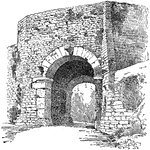Clipart tagged: ‘ertuscan’

A Graeco-Ertuscan Chariot
"The chariot was discovered in 1903 in an Ertuscan cemetery near Rome. It dates from perhaps 600 B.C.…

An Ertuscan Arch
"The Italian city of Volterra still preserves in the Porta dell' Arco an interesting relic of Ertuscan…

Lictors with Fasces
"The symbolic fasces borne by these officers were probably of Ertuscan origin. The Tarquins are said…